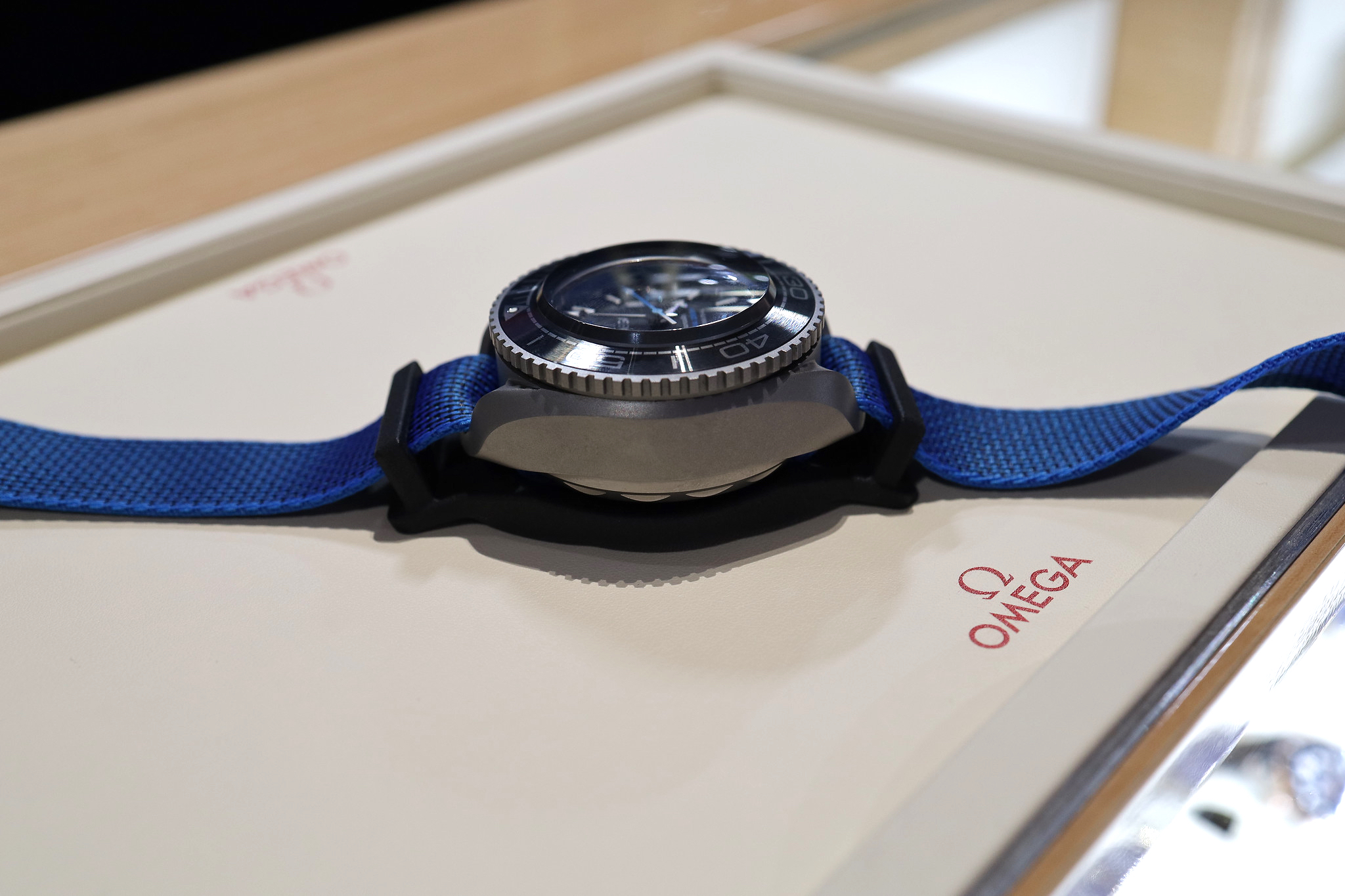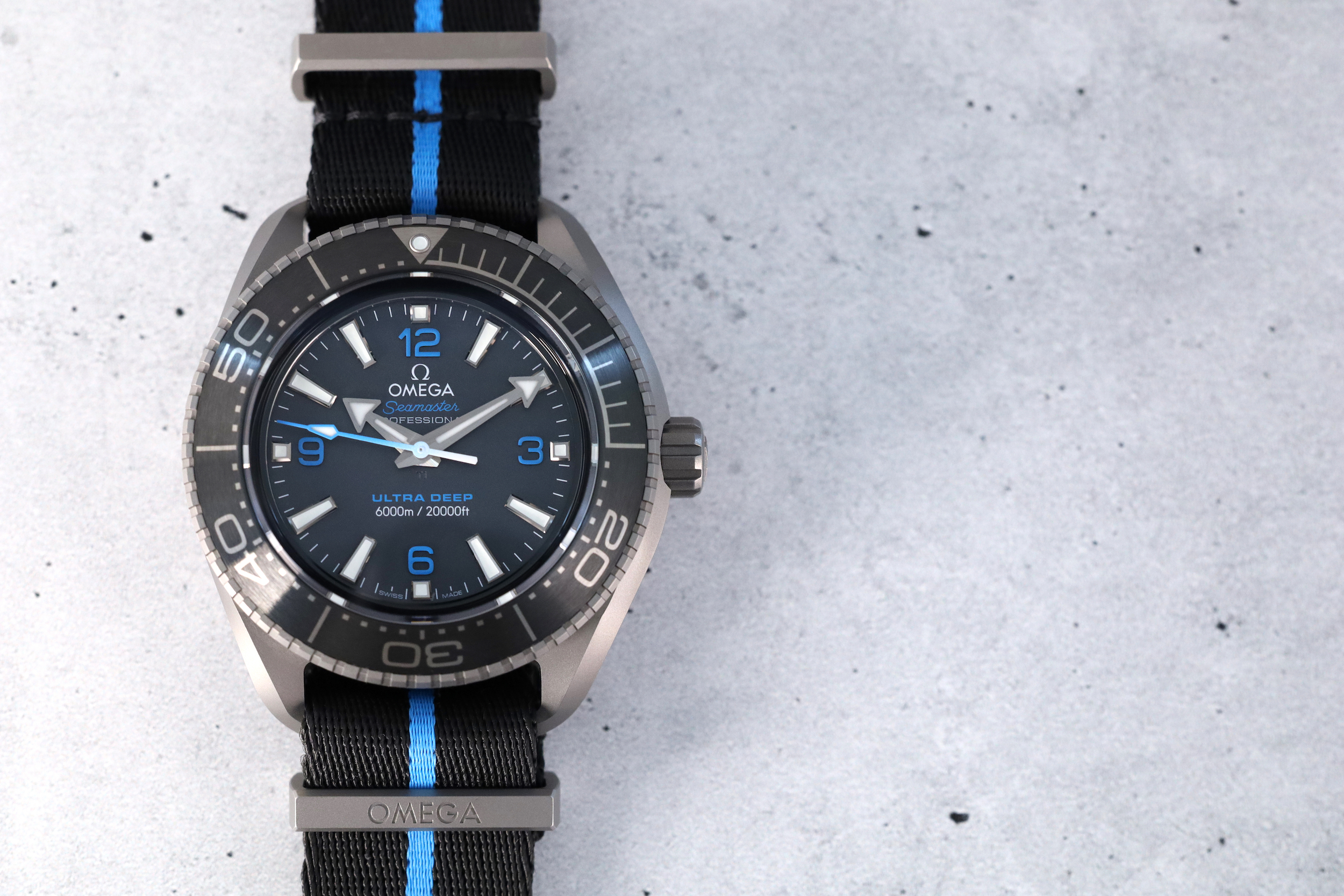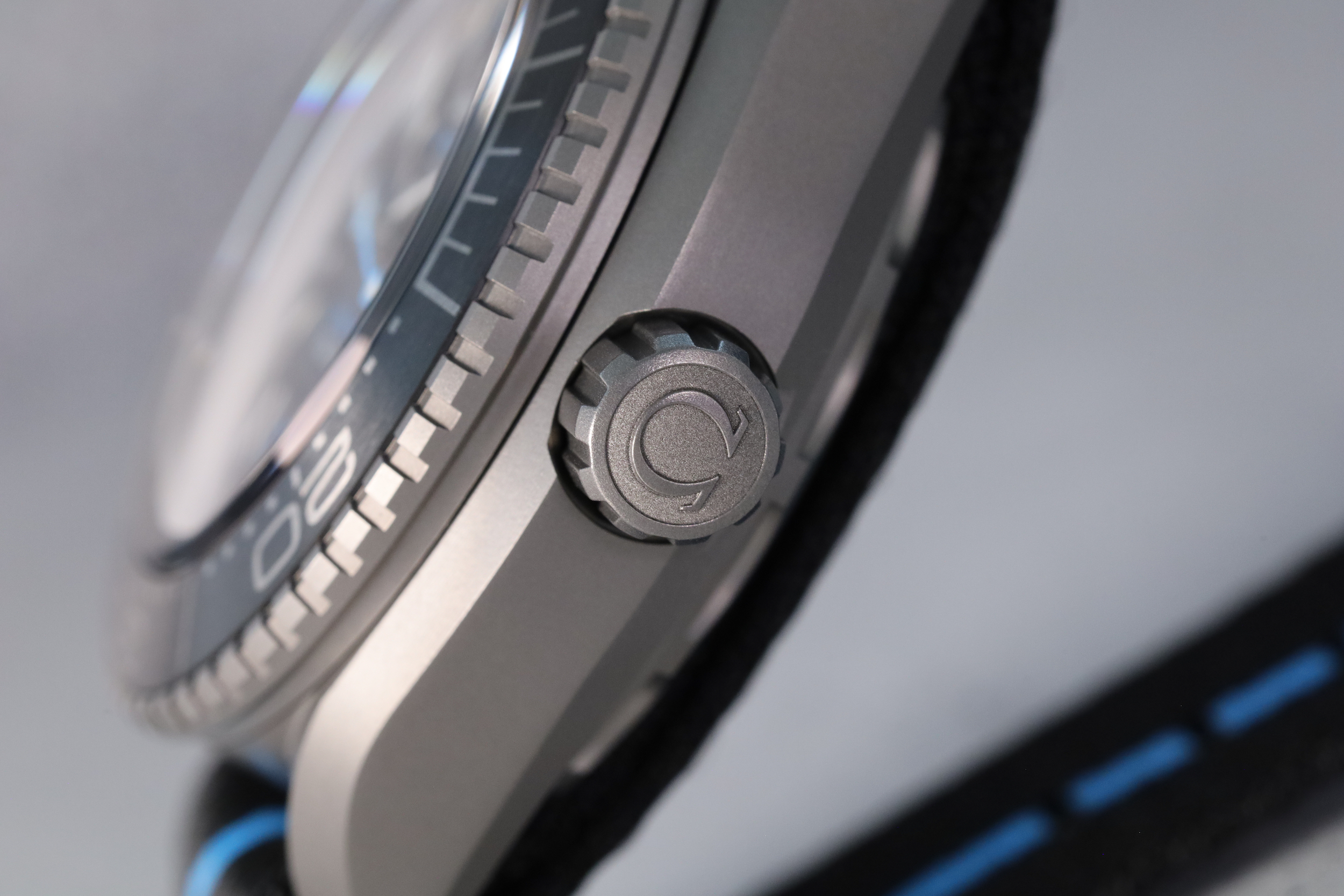Omega created the Ultra Deep Professional prototype watch that was used during a world record-breaking saturation dive at the Mariana Trench in 2019, which ultimately led to a regular production version in 2022.
The 2022 Seamaster Planet Ocean 6000M Ultra Deep is currently the world’s deepest production dive watch, with a depth rating of 6,000 meters. Technically, CX Swiss Military does make a timepiece with the same 6,000 meters rating; however, that watch is not ISO 6425:2018 or METAS certified. Considering the level of R&D required, it’s a record that could stand for many years. The depth rating is, of course, important in a professional dive watch. However, it’s not the only factor to consider — and Omega pulled out all stops to make this timepiece very special beyond just sheer water resistance.
Case
During the Five Deeps Expedition in 2019, the original prototype Ultra Deep Professional was strapped to the exterior of a DSV (Deep Submergence Vehicle) named Limiting Factor when Victor Vescovo reached the bottom of the Mariana Trench — the deepest point on the Earth — achieving the current world record for the deepest dive of 10,935 meters. Interestingly, that watch is actually rated down to a depth of 15,000 meters, which was achieved using a considerably thicker case and crystal, compared to the eventual production version, which is officially marked with an impressive 6,000 meters on the dial (the watch is METAS certified so water resistance is tested at +25% above the indicated water resistance so it’s actually able to go 7,500 meters deep). Both the prototype and production Ultra Deep models are made of grade 5 titanium, just like the hull of the DSL Limiting Factor.

While the Ultra Deep is certainly wearable, it’s chunky at 45.5 mm x 18 mm (and with a sizable lug-to-lug distance of 54 mm). It fit the width of my 7″ wrist fine, but smaller wrists may have trouble. Like the 44 mm Rolex Deep Sea, this is a big dive watch and works best on larger wrists. Being made of grade 5 titanium, the Ultra Deep is deceptively lightweight, and the smooth matte finish of the sandblasted exterior feels really well-made. I noticed a small vertical machining mark near the inside of the left lower lug; however, it was only visible under high magnification, and I’ve seen far more noticeable errors even on more expensive watches. Besides, overall, this is one of the most robust mechanical watch case constructions, if not the most, I’ve ever seen. Although when you think about it, it should be considering the depth rating.
The Ultra Deep watch we tested (Ref. 215.92.46.21.01.001) is the most technically advanced of seven variations offered by Omega at launch, thanks to its monoblock grande 5 titanium case, which is the lightest weight, most robust option, and features Manta lugs built into the case. Like Tudor’s purpose-built Pelagos FXD Marine Nationale, this design requires a NATO-style strap. The benefit of the robust lugs and the one-piece strap is that there’s less chance of the lugs breaking, and if one does, the strap still stays in place. Compared to the stainless steel models (that all have titanium casebacks), which weigh 170 grams on a rubber strap and 254 grams on a stainless steel bracelet, the all-titanium model at 123 grams does not feel heavy at all.
In contrast to the polished bezel insert found on the other six Ultra Deep references, the circular brushed black ceramic bezel ring — and diving scale in Liquidmetal™, which all models have — is pretty impressive and would be my personal preference over the polished inserts. According to Omega, “Composed of titanium, zirconium, and copper, this amorphous alloy is three times as hard as stainless steel. When bonded with ceramic parts, Liquidmetal™ can be offered in contrasting finishes (brushed or polished), thanks to the difference in hardness between the two materials. While the Liquidmetal™ markings are unique to Omega, the ceramic portion of the bezel insert, like many modern divers’ watches, is highly scratch-resistant, chemically inert, hypoallergenic, environmentally friendly, and non-magnetic.
As far as the case material, grade 5 titanium has a slightly darker look than stainless steel, and is more prone to scratching, however, as mentioned above, it’s the same material used to construct the hulls of diving submersibles, not to mention it’s biochemically inert (making it hypoallergenic), as well as being highly corrosion resistant, and able to withstand extreme temperatures.
For the other six, more fashionable yet less technically perfect versions of the Ultra Deep, Omega created a new high-performance stainless steel alloy. So, although the titanium version is the closest to the actual prototype, the steel models still offer unique technical aspects and have the same exterior dimensions and official level of water resistance.
O-MEGASTEEL is the name of the new alloy, which Omega describes as “Through an ingenious Pressure Electro Slag Remelting process, the material obtains a high purity, allowing for a greater polish and incomparable shine. Stripped of its nickel and boosted with nitrogen and manganese, O-MEGASTEEL also offers a brighter white color, as well as superior strength and a hardness that is 40% to 50 % higher than conventional steel. As well as being non-ferromagnetic, the unique composition also delivers exceptional resistance to corrosion for a longer-lasting appearance.”
When the titanium unidirectional 120-click dive bezel is rotated, it feels excellent; however, I noticed some minor wiggle in the bezel (you can see the triangle on the bezel is off-center from 12 by about 1-2 millimeters in the wristshot above). This is a sample model, so that’s always a factor. Nevertheless, we asked Omega about this issue and they stated “I am not aware of any bezel issues but what they may be experiencing is crystal distortion which may cause it to be perceived as misaligned due to the shape of the crystal causing an illusion of misalignment from different angles.” We also asked master watchmaker, Jordan Ficklin, and he said “this is a bezel that’s accurate for diving to within 30 seconds even with the wobble. For its intended use, it doesn’t need to be any more accurate than that; in fact, the wobble may make it easier to rotate with gloves on. It may make it easier to clean out after a dive. The design may make it less prone to breaking or wearing out. I have no way of knowing what the engineers had in mind, but it probably wasn’t the super picky watch collector.”
One of my favorite details of the Ultra Deep’s case construction, despite the fact that very few people will really ever need to use a helium escape valve, is that it’s so well built — regardless of whether you go with the titanium or steel version — that no helium escape valve was required. The Ultra Deep meets the highest dive watch standard for saturation divers, which is based on the fourth edition ISO 6425:2018 specification.
Protecting the case, one of the most important elements of any watch is the crystal. In this case, it’s a very special bevel-edge-domed protuberant sapphire crystal, with anti-reflective treatments on both sides for superior visibility. The robust case, screw-locked titanium crown (7.5 mm in diameter) that is set slightly within the case flank, which effectively acts as crown guards, screw-down titanium caseback, and multiple gaskets, allows for such a watch to perform at record-breaking depths. However, the bulging (protuberant) design of the sapphire crystal is one of the most important elements in keeping this watch water-tight at extreme pressure.
To ensure the integrity of our timepieces at depth, all watches are fully immersed in water, and pressure is applied up to the point of guaranteed water resistance.
ISO 6425:2018-10 Divers’ Watch
As you would expect, Omega’s Ultra Deep meets the specifications required by the latest fourth edition ISO 6425:2018 standard for saturation divers’ watches.
“To guarantee the Ultra Deep’s ability as a divers’ watch for saturation diving, the timepiece has been tested to meet the ISO 6425:2018 standard. Nine tests are performed and include examinations for Visibility, Magnetic-Resistance, Temperature Cycling, Salt Spray, Shock-Resistance, Water-Resistance, Free-Fall Shock, Resistance of Attachments, and Saturation Diving,” according to Omega.
Many dive watches that meet the requirements are not actually tested; however, in this case, Omega has gone above and beyond, and METAS certifies that the watch has been tested in conformity with the required criteria.
Dial
For the titanium Ultra Deep model we reviewed, it comes with a black ceramized grade 5 titanium dial, which is stamped with “Ti” just under the hand stack. The other three dial options, which each come with either a stainless steel bracelet or a rubber strap, are a white lacquered dial, a brown to gray lacquered gradient dial, and a blue to black lacquered gradient dial.
While the titanium dial does not have the cool-looking gradient seen on two of the lacquered dials, it’s titanium and seems more purpose-built, plus Omega subtly included a gradient white-to-cyan central seconds hand, which matches the cyan hue of the applied Arabic numerals located at 12, 3, 6, and 9. The hour/minute hands and applied hours markers are 18K white gold on all seven Ultra Deep references and filled with a generous amount of white lume that glows green. The glow on the arrow-shaped minute hand and bezel dot has a slight yellow hue to accentuate them, and that enhances visibility, particularly underwater, as those are the crucial time-controlling elements when diving. For a watch built with this level of purpose, it would have been nice to also see the rest of the bezel diving scale lumed. Even barring that, this is still some of the brightest and highest-performance lume I’ve ever seen.
“Protecting the display of this watch is a unique sapphire crystal produced internally by OMEGA, using a specific process called EFG. “Edge-defined Film-fed Growth” creates a crystal that is absolutely defect-free, to make the most of sapphire’s unique properties. Sapphire plates are grown, using the EFG process, then cut into discs, machined, and polished, to create sapphire crystals of extraordinary strength and clarity, ensuring an unhindered vision of the display at all times, according to Omega.
As it should be on a professional watch, the dial markings are highly legible, with no date or unneeded information.
Movement
Inside, the watch is driven by the Omega caliber 8912, which is an automatic 3.5Hz mechanical movement with a Co-Axial escapement (significantly reducing the need for lubrication and hence the need for servicing), free-sprung balance with a silicon balance spring, two barrels mounted in series, and automatic winding in both directions, with a maximum power reserve of 60 hours. The movement is METAS-certified and is therefore a Master Chronometer.
Resistant to magnetic fields reaching 15,000 gauss, a rating that exceeds most watches on the market, and adjusted to 0/+5 seconds per day, which is twice as precise as a standard officially certified chronometer (which is rated -4/+6 seconds per day) — the movement is as impressive as the case design.
Additional features include a time zone function that allows you to quickly jump the hour hand to when setting the time. Being a five-figure dive watch, even though you cannot see the movement, it’s nice to know that the movement has been given a luxurious Geneva waves arabesque decoration.
“Behind the elegance of every Master Chronometer timepiece is the highest level of testing: 8 tests over 10 days, to ensure superior precision and anti‑magnetic resistance. Our Master Chronometer watches are tested and certified twice. Firstly, the movement is tested by the Official Swiss Chronometer Control (COSC) with precision criteria of -4/+6 seconds per day. Then the complete watch and its movement undergo eight Master Chronometer tests set by the Swiss Federal Institute of Metrology (METAS) with criteria of 0/+5 seconds per day,” according to Omega.
Additionally, a selection of test watches undergoes a shock-resistance test equivalent to 5,000 g (1 g is equal to the force of gravity at the Earth’s surface) to ensure our complex mechanical mechanisms are also extraordinarily robust. Not just for everyday use but for highly active sports.
Verdict
At 18 mm in height, including the crystal, and even with the added height of the NATO-style strap, which is required due to the fixed titanium Manta lug design, you’re looking at a watch that protrudes approximately 20 mm. Compared to the height of Omega’s original prototype Ultra Deep Professional (28 mm), the production version of the Ultra Deep is rather thin.
Compared to regular dive watches you’d find on the market, however, the Ultra Deep is unquestionably thick — but this is no ordinary dive watch. Even the Rolex Sea-Dweller Deepsea, which is 44 mm in diameter, has a height of 17.7 mm, yet the Omega annihilates it in terms of water resistance with a rating that’s 2,100 meters deeper.
Many years ago, Bell & Ross made a watch called the Hydromax, that could achieve a record depth of 11,100 meters at the time, in a relatively small and thin case, however, it’s no longer in production, and perhaps most importantly, it had a quartz not a mechanical movement and required an oil filled case to prevent being crushed at those depths. It would certainly be a nightmare to service, and Bell & Ross actually had Sinn handling the production, but it was eventually discontinued.
The CX Swiss Military is a behemoth and is made by a company that has little brand recognition, so the only true competitor to the Omega Ultra Deep is the Rolex Deepsea. The Rolex is smaller, though not by much, and also costs roughly two to three grand more, depending on which reference.
There are six other references in addition to the most authentic version of the Ultra Deep that we reviewed. Having a traditional spring bar and lug connection to the bracelets and straps is likely to appeal to more people, myself included. Note that, as mentioned above, if you do select one of the Omega stainless steel models, the weight increases. You do save money, but you lose the authentic dive nature of the original prototype, and you lose the Manta lugs. Consider that having to always wear a traditional one-piece Nato strap, the watch is always going to sit higher up on the wrist, but you also have the reassuring one-piece strap that will keep the watch on your watch even if a lug breaks.
Although we did not test any of the stainless steel Ultra Deeps, knowing what they weigh, the lightweight offered by the titanium is much appreciated and made the watch wear quite well in that regard. It would be interesting to see the titanium offered with standard spring bar-equipped lugs, so you can throw it on something like a rubber strap and enjoy the weight benefit of titanium as well as the comfort, convenience, and lower height on your wrist of a more traditional timepiece. That said, for the dive purest, wanting the closest thing to the record-breaking prototype Ultra Deep Professional, the watch we tested is the best choice.
Being able to say your watch can crush the Deep Sea might be worth the high price of entry, or perhaps owning the world’s deepest dive watch, that’s been tested in the Mariana Trench, may be worth the price of admission. Whatever your motivation, there’s really no question in my mind that the Ultra Deep is the diving watch champion and, by way of technical specifications, perhaps the ultimate professional watch. You be the judge, what other mechanical watch is engineered to this high of a level?
Retail for the titanium Omega Seamaster Planet Ocean 6000M Ultra Deep (Ref. 215.92.46.21.01.001) as tested is $12,300.
Learn more at Omega.
SPECIFICATIONS:
Omega Seamaster Planet Ocean 6000M Ultra Deep
Reference: 215.92.46.21.01.001
Year: 2022
Case Material: Titanium (Ceramic bezel insert)
Total Weight: 123 grams
Case Diameter: 45.5 mm
Case Thickness: 18 mm
Lug-to-lug: 54 mm
Lug width: 21 mm
Crown Diameter: 7.5 mm
Glass: Sapphire crystal
Movement: Omega caliber 8912 (METAS Certified Master Chronometer with Co-Axial technology)
Depth Rating: 6,000 meters (tested to 7,500 meters to meet METAS 25% safety requirement)













